| This article needs additional citations for verification. Please help improve this article by adding citations to reliable sources. Unsourced material may be challenged and removed. Find sources: "Sikorsky HH-52 Seaguard" – news · newspapers · books · scholar · JSTOR (April 2008) (Learn how and when to remove this message) |
| HH-52 Seaguard | |
|---|---|
 A U.S. Coast Guard HH-52A Seaguard helicopter A U.S. Coast Guard HH-52A Seaguard helicopter | |
| General information | |
| Type | SAR/utility helicopter |
| National origin | United States |
| Manufacturer | Sikorsky Aircraft |
| Status | Retired in 1989 |
| Primary user | United States Coast Guard |
| Number built | 175 |
| History | |
| Introduction date | 1961 |
| First flight | 14 May 1958 |
The Sikorsky HH-52 Seaguard (company designation S-62) is an early amphibious helicopter designed and produced by American helicopter manufacturer Sikorsky Aircraft. It was the first of the company's amphibious rotorcraft to fly and the United States Coast Guard's first turbine-powered helicopter and first amphibious helicopter.
The S-62 was originally developed as a commercial venture during the late 1950s. It combined the dynamic elements of the Sikorsky S-55 with a boat hull-shaped fuselage and a single lightweight turboshaft engine. The prototype S-62 conducted its maiden flight on 22 May 1958, powered by a single General Electric T58-GE-6 turboshaft engine. It underwent evaluation at the Naval Air Test Center in Patuxent River, Maryland, at Sikorsky's own expense as part of its effort to promote the S-62 to the United States Coast Guard (USCG).
The USCG would procure 99 S-62s, which it initially designated as the HU2S-1G Seaguard, and later redesignated as the HH-52A Seaguard. It was primarily operated by the USCG for air-sea rescue missions. Various other operators opted to procure the S-62 for their own purposes, from airliners to utility transporters, and foreign air services. It was widely used into the 1980s, when many operators elected to replace the type with newer rotorcraft. The HH-52 was withdrawn from USCG service during 1989 in favor of nonamphibious rotorcraft, such as the Eurocopter HH-65 Dolphin, which rely solely on the use of a winch from a low hover to conduct rescue operations.
Development

Development of the S-62 was launched by Sikorsky during the late 1950s; the initiative was initially pursued as an independent commercial venture. In concept, the project combined the dynamic elements of the earlier Sikorsky S-55 with a boat hull-shaped fuselage and a single lightweight turboshaft engine. This was a relatively ambitious design for the era, being the first of Sikorsky's amphibious helicopters.

On 14 May 1958, the prototype S-62 performed its maiden flight; in doing so, it had beat its larger Sikorsky S-61 sibling into flight by almost a year. This prototype was powered by a single General Electric T58-GE-6 turboshaft that had been derated from 1,050 hp to 670 hp, powering identical main and tail rotors to those of the S-55.
At Sikorsky's own expense, it funded a "fly before you buy" test program at the Naval Air Test Center in Patuxent River, Maryland; the company actively promoted the type to the United States Coast Guard (USCG) in particular. The results of this test program was largely positive, confirming Sikorsky's performance claims and its suitability for the service. Accordingly, on 21 June 1962, Sikorsky was issued an initial production contract for the type. On 9 January 1963, the first of 99 production helicopters was delivered to the USCG. On 17 January 1969, the final example were delivered by the company.
Design

Perhaps the most prominent feature of the S-62 is its boat hull fuselage, which was more compact, but otherwise similar to the preceding Sikorsky S-61 (adopted by the US Navy as the SH-3 Sea King). This fuselage is watertight, facilitating landings on water and snow alike, and furnished with two outrigger floats that help the rotorcraft resist both pitching and rolling motions while on the water's surface. These outrigger floats also accommodated the landing gear, which was retractable. To maintain its position while on the water, it was able to deploy an anchor.
Although the S-62 bore little visual resemblance to the Sikorsky S-55, it used many of the same components. It was powered by a single General Electric T58-GE-8B turboshaft engine, capable to generating up to 1,250 hp (930 kW); it was a derated version of the T58-GE-10 powerplant used on the larger, twin-engined SH-3. The S-62 had sufficient power to carry up to 12 passengers, or six litters, along with a crew of three.
Operational history
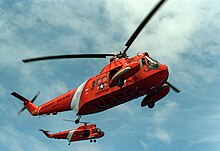
One prominent early use of the S-62 was with the operator San Francisco and Oakland Helicopter Airlines, one of the first helicopter airlines to operate without a federal subsidy, and the first to operate exclusively using turbine engine helicopters; the airline commenced passenger flights using a pair of two leased S-62s in June 1961, each of which being configured to carry up to 10 passengers. On 21 December of that year, rival operator Los Angeles Airways performed the first scheduled service using an American turbine-powered helicopter via a leased S-62. By June 1962, three S-62s were reportedly in operation for specialized transportation purposes, such as servicing offshore oil rigs in the Gulf of Mexico, with Petroleum Helicopters. Other early civilian operators included Okanagan Helicopters, which used its S-62s to supply remote radar installations, and the Canadian Department of Transport, which had the type fly resupply missions to its lighthouses.
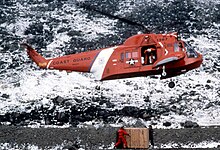
A large fleet of 99 S-62s was purchased by the US Navy's Bureau of Aeronautics on behalf of the USCG, who operated the type primarily for search and rescue missions. It was initially designated HU2S-1G Seaguard, but was redesignated as the HH-52A Seaguard in 1962. The HH-52 was commonly dispatched aboard the USCG's larger cutters and icebreakers. The turbine-powered helicopter could carry greater payloads and fly faster than many preceding aircraft, such as the H-19 (S-55). Being designed to be amphibious, the installation of additional flotation gear was not required for over-water flights, and rescues could be conducted by simply landing on the water. Water pickups were considered to be quicker than hoisting survivors up to the helicopter.
Across its services life, the HH-52 fleet played an active role during various emergencies and other circumstances. During the aftermath of Hurricane Betsey in 1965, the type rescued 1,200 people. The HH-52 was periodically used to provide logistical support in Antarctica. One HH-52 was present for the foundering of the oil tanker Burmah Agate on 1 November 1979, facilitating in the rescue of personnel from the affected vessels.
The HH-52 fleet was active for a total of 26 years, during which it reportedly was responsible for saving in excess of 15,000 people from various forms of life-threatening situations. Having been eclipsed by newer rotorcraft, the final flight of a HH-52 took placed on 12 September 1989, after which the type was officially withdrawn from USCG service. It was primarily replaced by the Eurocopter HH-65 Dolphin, a conventional nonamphibious helicopter.
Variants
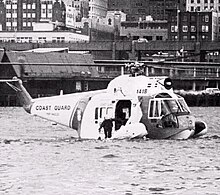
- S-62
- Prototype. First flew on 14 May 1958.
- S-62A
- Amphibious transport helicopter, powered by a General Electric CT58-110-1 turboshaft engine, with accommodation for up to 11 passengers. The S-62A was the first production version.
- S-62B
- One S-62 was fitted with the main rotor system of the Sikorsky S-58.
- S-62C
- Company designation of the HH-52A Seaguard.
- S-62J
- Produced under license in Japan by Mitsubishi.
- HU2S-1G
- Original designation of the HH-52A Seaguard. Redesignated HH-52A in 1962.
- HH-52A Seaguard
- Search and rescue helicopter for the United States Coast Guard; 99 built including 1 transferred to Iceland.
Operators
Military/Government

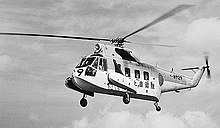
Civilian
Aircraft on display



While the type remains in service, a number of Seaguards are on display at museums around the world:
Japan
- 53-4774 - S-62J on static display at Hamamatsu Air Park, Hamamatsu AB, Shizuoka.
United States
- USCG 1355 – HH-52A on static display at the National Naval Aviation Museum at Naval Air Station Pensacola in Pensacola, Florida.
- USCG 1357 – At Dillingham Airfield in Mokulēia, Hawaii.
- USCG 1370 – HH-52A on static display at Freedom Park in Omaha, Nebraska.
- USCG 1375 – HH-52A in storage at Yanks Air Museum in Chino, California.
- USCG 1378 – HH-52A on static display at the Battleship Memorial Park in Mobile, Alabama.
- USCG 1383 – HH-52A on static display at the American Helicopter Museum & Education Center in West Chester, Pennsylvania.
- USCG 1384 – On static display at CGAS Elizabeth City in Elizabeth City, North Carolina.
- USCG 1389 – At Delgado Community College in New Orleans, Louisiana.
- USCG 1394 – HH-52A on display at the Mid-Atlantic Air Museum in Reading, Pennsylvania.
- USCG 1395 – HH-52A on static display at the Classic Rotors Museum in Ramona, California.
- USCG 1398 – HH-52A in storage at CGAS Elizabeth City in Elizabeth City, North Carolina. It was previously located at Black River Technical College in Pocahontas, Arkansas.
- USCG 1397 – At Amarillo College in Amarillo, Texas.
- USCG 1415 – HH-52A on static display at the Museum of Flight in Seattle, Washington.
- USCG 1416 – HH-52A at Broward College in Pembroke Pines, Florida.
- USCG 1423 – HH-52A cockpit section only on static display at the National Museum of Naval Aviation at Naval Air Station Pensacola in Pensacola, Florida.
- USCG 1426 – HH-52A on static display at the Steven F. Udvar-Hazy Center of the National Air and Space Museum in Chantilly, Virginia. It was restored by the Coast Guard Aviation Association and went on display on 14 April 2016.
- USCG 1428 – HH-52A on static display at the New England Air Museum in Windsor Locks, Connecticut.
- USCG 1429 – HH-52A on static display at the Intrepid Sea, Air & Space Museum in New York, New York.
- USCG 1450 – HH-52A on static display at the Pima Air & Space Museum in Tucson, Arizona
- USCG 1455 – HH-52A on static display at the Aviation Hall of Fame and Museum of New Jersey in Teterboro, New Jersey.
- USCG 1459 – HH-52A in storage at the Naval Air Station Glenview Museum in Glenview, Illinois. It was previously on display at the Museum of Science and Industry.
- USCG 1462 – HH-52A on static display at the Naval Air Station Wildwood Aviation Museum in Erma, New Jersey.
- USCG 1466 – HH-52A on static display at the Selfridge Military Air Museum at Selfridge Air National Guard Base in Mount Clemens, Michigan.
Philippines
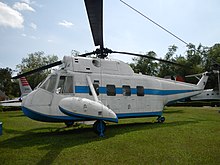
- 62018 – On static display at the Philippine Air Force Museum in Pasay, Manila.
South Africa
- 62-062 – S-62A on static display in Strand, Western Cape. It has been painted to resemble SH-3 bureau number 150142.
Thailand
- On static display at the Thai Police Aviation Division operations base in Bangkok, Thailand.
Specifications (HH-52A)
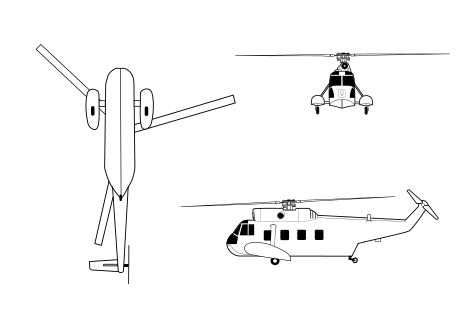
Data from Jane's All The World's Aircraft 1969–70
General characteristics
- Crew: 3
- Capacity: 3,127 lb (1,418 kg) payload
- Length: 44 ft 6.5 in (13.576 m)
- Height: 16 ft 0 in (4.88 m)
- Empty weight: 5,083 lb (2,306 kg)
- Max takeoff weight: 8,300 lb (3,765 kg)
- Powerplant: 1 × General Electric T58-GE-8 turboshaft engine, 730 shp (540 kW) (de-rated from 1,250 shp (932 kW))
- Main rotor diameter: 53 ft (16 m)
- Main rotor area: 2,206 sq ft (204.9 m)
- Blade section: - NACA 0012
Performance
- Maximum speed: 95 kn (109 mph, 176 km/h) at sea level
- Cruise speed: 85 kn (98 mph, 157 km/h)
- Range: 412 nmi (474 mi, 763 km)
- Service ceiling: 11,200 ft (3,400 m)
- Rate of climb: 1,080 ft/min (5.5 m/s)
See also

Related development
Related lists
References
Citations
- ^ "Sikorsky HH-52A Seaguard | National Air and Space Museum". airandspace.si.edu. Retrieved 2024-06-23.
- ^ "Sikorsky HH-52A Seaguard". history.uscg.mil. 22 October 2020. Retrieved 1 August 2022.
- ^ McGowen 2005, p. 84.
- McGowen 2005, pp. 84, 118.
- ^ Ruane, Michael E. (4 March 2016). "The story of the helicopter that saved 22 sailors from burning ships was forgotten. Until now". Washington Post. Retrieved 2 June 2017.
- Chiles, James R. The God Machine: From Boomerangs to Black Hawks: The Story of the Helicopter. p. 218.
- "New Helicopter Service". Flying. Vol. 69, no. 2. August 1961. p. 8. ISSN 0015-4806.
- Boyes, Lindy (December 1961). "San Francisco & Oakland Helicopter Airlines". Flying. Vol. 69, no. 6. p. 44. ISSN 0015-4806.
- Leyes and William Fleming 2007, p. 255.
- "Big Business". Flying. Vol. 70, no. 6. June 1962. pp. 32–33. ISSN 0015-4806.
- "Rotary-Wing Aircraft". Flying. Vol. 69, no. 5. November 1961. p. 154. ISSN 0015-4806.
- McGowen 2005, p. 155.
- "Mitsubishi S-62J - Helicopter Database". helis.com. 30 June 2012. Archived from the original on 30 June 2012.
- ^ "World Helicopter Market 1968". p. 53. Retrieved 25 February 2013.
- "JSDAF S-62". Demand media. Retrieved 26 February 2013.
- "Japan Coast Guard: Aircraft Data File - J-HangarSpace: Information on Japanese Aviation". www.j-hangarspace.jp.
- "World Helicopter Market 1968". flightglobal.com. p. 54. Retrieved 26 February 2013.
- "Phil Air Force S-62". Demand media. Retrieved 26 February 2013.
- "Sikorsky HH-52A Seaguard" (PDF). uscg.mil. Retrieved 24 February 2013.
- "Icelandic Coast Guard Service". aeroflight.co.uk. Retrieved 26 February 2013.
- "World Helicopter Market 1968". flightglobal.com. p. 55. Retrieved 26 February 2013.
- Endres 1979, p. 12.
- "S-62 (HH-52A, S-62A, S-62B, S-62C)". sikorskyarchives.com. Retrieved 26 February 2013.
- "SFO-Helicopter Airlines". Demand media. Retrieved 26 February 2013.
- "HH-52 SEAGUARD". navalaviationmuseum.org. Naval Aviation Museum Foundation. Retrieved 2 June 2017.
- "Airframe Dossier – Sikorsky HH-52A Seaguard, s/n 1355 USCG, c/n 62-024". Aerial Visuals. AerialVisuals.ca. Retrieved 2 June 2017.
- "Airframe Dossier – SikorskyS-62 / H-52 / HU2S, s/n 1370 USCG". Aerial Visuals. AerialVisuals.ca. Retrieved 2 June 2017.
- "Sikorsky S-62A Seaguard (HH-52A)". Yanks Air Museum. Retrieved 2 June 2017.
- "Airframe Dossier – SikorskyS-62 / H-52 / HU2S, s/n 1375 USCG, c/r N9165Q". Aerial Visuals. AerialVisuals.ca. Retrieved 2 June 2017.
- "Aircraft". USS Alabama Battleship Memorial Park. 5 January 2017. Retrieved 2 June 2017.
- "Sikorsky S-62 / HH 52A Sea Guardian". American Helicopter Museum & Education Center. Archived from the original on 9 August 2017. Retrieved 2 June 2017.
- "Airframe Dossier – Sikorsky HH-52A Seaguard, s/n 1383 USCG, c/n 62-064". Aerial Visuals. AerialVisuals.ca. Retrieved 2 June 2017.
- "SIKORSKY HH-52A "SEAGUARD"". Mid-Atlantic Air Museum. Archived from the original on 9 July 2017. Retrieved 2 June 2017.
- "Airframe Dossier – Sikorsky HH-52A Seaguard, s/n 1395 USCG". Aerial Visuals. AerialVisuals.ca. Retrieved 2 June 2017.
- "Airframe Dossier – Sikorsky HH-52A Seaguard, s/n 1398 USCG, c/n 62-083". Aerial Visuals. AerialVisuals.ca. Retrieved 2 June 2017.
- "Sikorsky HH-52 Seaguard". The Museum of Flight. Retrieved 2 June 2017.
- "c/n 62-100". helis.com. Retrieved 2 June 2017.
- "Airframe Dossier – Sikorsky HH-52A Seaguard, s/n 1423 USCG, c/n 62.111". Aerial Visuals. AerialVisuals.ca. Retrieved 2 June 2017.
- "Sikorsky HH-52A Seaguard". Smithsonian National Air and Space Museum. Archived from the original on 23 May 2017. Retrieved 2 June 2017.
- Connor, Roger (14 March 2016). "Celebrating the Centennial of Coast Guard Aviation with the Seaguard". Smithsonian National Air and Space Museum. Retrieved 2 June 2017.
- "Phoenix Project". Coast Guard Aviation Association. Retrieved 2 June 2017.
- "Sikorsky HH-52A (S-62A) 'Seaguard'". New England Air Museum. Archived from the original on 26 July 2017. Retrieved 2 June 2017.
- "Aircraft COLLECTION". Intrepid Sea, Air & Space Museum Complex. Archived from the original on 19 December 2015. Retrieved 2 June 2017.
- "Airframe Dossier - Sikorsky HH-52A Seaguard, s/n 1429 USCG, c/n 62-117". Aerial Visuals. AerialVisuals.ca. Retrieved 2 June 2017.
- "SEAGUARD". Pima Air & Space Museum. PimaAir.org. Archived from the original on 21 September 2017. Retrieved 2 June 2017.
- Castiglione, Roger A.; Rethage, Fritz (October 2016). "Self Guided Tour of The Aviation Hall of Fame & Museum of New Jersey" (PDF). The Aviation Hall of Fame of New Jersey. Archived from the original (PDF) on 27 September 2017. Retrieved 2 June 2017.
- Kukulka, Alexandra (10 June 2016). "Organizations seek new home for Naval Air Station Glenview Museum". Chicago Tribune. Retrieved 2 June 2017.
- "Airframe Dossier – Sikorsky HH-52A Seaguard, s/n 1459 USCG, c/n 62.138". Aerial Visuals. AerialVisuals.ca. Retrieved 2 June 2017.
- "HH-52 Helicopter". Naval Air Station Wildwood Aviation Museum. NASW Aviation Museum. Archived from the original on 9 August 2017. Retrieved 2 June 2017.
- "Airframe Dossier – Sikorsky HH-52A Seaguard, s/n 1462". Aerial Visuals. AerialVisuals.ca. Retrieved 2 June 2017.
- "HH-52 SEAGUARD". Selfridge Military Air Museum. Archived from the original on 10 September 2017. Retrieved 2 June 2017.
- "Airframe Dossier – Sikorsky HH-52A Seaguard, s/n 1466 USCG, c/n 62145". Aerial Visuals. AerialVisuals.ca.
- "Airframe Dossier – Sikorsky HH-52A Seaguard, s/n 62018 PhiAF, c/n M62-018". Aerial Visuals. AerialVisuals.ca. Retrieved 2 June 2017.
- "c/n 62-062". helis.com. Retrieved 2 June 2017.
- Taylor 1969, pp. 434–434.
- ^ Sikorsky Preflight Reference Cards
- Lednicer, David. "The Incomplete Guide to Airfoil Usage". m-selig.ae.illinois.edu. Retrieved 16 April 2019.
Bibliography
- Endres, Günter G. World Airline Fleets 1979. Hounslow, UK: Airline Publications and Sales Ltd., 1979. ISBN 0-905117-53-0.
- Leyes, Richard A. and William A. Fleming. The History of North American Small Gas Turbine Aircraft Engines. American Institute of Aeronautics and Astronautics, 2007. ISBN 1-563473-32-1.
- McGowen, Stanley S. Helicopters: An Illustrated History of Their Impact. ABC-CLIO, 2005. ISBN 1-851094-68-7.
- Taylor, John W. R. Jane's All The World's Aircraft 1969–70. London:Jane's Yearbooks, 1969.
External links
- The Last Flying Lifeboat on MAAM.org Archived 2007-06-19 at the Wayback Machine
- Naval Air Station Glenview Museum
- US Naval Air Station Wildwood Museum
- HELIS.com Sikorsky S-62/HH-52 Database
| Sikorsky S-55/S-58 family & S-62 | |||||||
|---|---|---|---|---|---|---|---|
| Military designations |    | ||||||
| Model numbers | |||||||
| License production |
| ||||||
| Modifications |
| ||||||
| Primary names | |||||||
| Accidents and incidents | |||||||
| Topics | |||||||
| See also: Sikorsky S-61 family • Sikorsky S-70 family | |||||||
| Sikorsky S-61 Sea King family | |||||||||
|---|---|---|---|---|---|---|---|---|---|
| Military designations |    | ||||||||
| Model numbers | |||||||||
| Foreign production |
| ||||||||
| Related |
| ||||||||
| Names | |||||||||
| Individual aircraft | |||||||||
| Topics | |||||||||
| See also: Sikorsky H-19 family • Sikorsky S-70 family | |||||||||
| Sikorsky aircraft | |
|---|---|
| Fixed-wing aircraft (company designations) | |
| Fixed-wing aircraft (military designations) | |
| Helicopters (company designations) | |
| Helicopters (military designations) | |
| Experimental aircraft | |
| United States helicopter designations, Army/Air Force and Tri-Service systems | |||||||||
|---|---|---|---|---|---|---|---|---|---|
| Numerical sequence used by USAAC/USAAF/USAF 1941–present; U.S. Army 1948–1956 and 1962–present; U.S. Navy 1962–present | |||||||||
| Army/Air Force sequence (1941–1962) |
| ||||||||
| Tri-Service sequence (1962–present) |
| ||||||||
| Not assigned | |||||||||